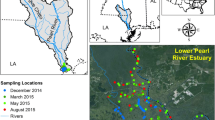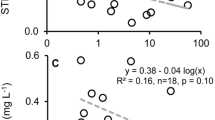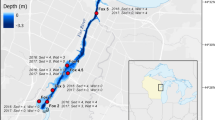Abstract
Using a natural gradient of dissolved organic carbon (DOC) source and concentration in rivers of northern Florida, we investigated how terrestrially-derived DOC affects denitrification rates in river sediments. Specifically, we examined if the higher concentrations of DOC in blackwater rivers stimulate denitrification, or whether such terrestrially-derived DOC supports lower denitrification rates because (1) it is less labile than DOC from aquatic primary production; whether (2) terrestrial DOC directly inhibits denitrification via biochemical mechanisms; and/or whether (3) terrestrial DOC indirectly inhibits denitrification via reduced light availability to—and thus DOC exudation by—aquatic primary producers. We differentiated among these mechanisms using laboratory denitrification assays that subjected river sediments to factorial amendments of NO3 − and dextrose, humic acid dosing, and cross-incubations of sediments and water from different river sources. DOC from terrestrial sources neither depressed nor stimulated denitrification rates, indicating low lability of this DOC but no direct inhibition; humic acid additions similarly did not affect denitrification rates. However, responses to addition of labile C increased with long-term average DOC concentration, which supports the hypothesis that terrestrial DOC indirectly inhibits denitrification via decreased autochthonous production. Observed and future changes in DOC concentration may therefore reduce the ability of inland waterways to remove reactive nitrogen.






Similar content being viewed by others
References
Alexander RB, Smith RA, Schwarz GE. 2000. Effect of stream channel size on the delivery of nitrogen to the Gulf of Mexico. Nature 403:758–61.
Arango CP, Tank JL, Schaller JL, Royer TV, Bernot MJ, David MB. 2007. Benthic organic carbon influences denitrification in streams with high nitrate concentration. Freshw Biol 52:1210–22.
Barnes RT, Smith RL, Aiken GR. 2012. Linkages between denitrification and dissolved organic matter quality, Boulder Creek watershed, Colorado. J Geophys Res 117:G01014.
Bernhardt E, Likens G. 2002. Dissolved organic carbon enrichment alters nitrogen dynamics in a forest stream. Ecology 83:1689–700.
Bledsoe E, Phlips E. 2000. Relationships between phytoplankton standing crop and physical, chemical, and biological gradients in the Suwannee River and plume region, U.S.A. Estuar Coasts 23:458–73.
Bukaveckas P, Robbins-Forbes M. 2000. Role of dissolved organic carbon in the attenuation of photosynthetically active and ultraviolet radiation in Adirondack lakes. Freshw Biol 43:339–54.
Burgin AJ, Yang WH, Hamilton SK, Silver WL. 2011. Beyond carbon and nitrogen: how the microbial energy economy couples elemental cycles in diverse ecosystems. Front Ecol Environ 9:44–52.
Canfield DE, Glazer AN, Falkowski PG. 2010. The evolution and future of Earth’s nitrogen cycle. Science 330:192–6.
Carpenter SR, Pace ML. 1997. Dystrophy and eutrophy in lake ecosystems: implications of fluctuating inputs. Oikos 78:3–14.
Cebrian J. 1999. Patterns in the fate of production in plant communities. Am Nat 154:449–68.
Cohen MJ, Heffernan JB, Albertin A, Martin JB. 2012. Inference of riverine nitrogen processing from longitudinal and diel variation in dual nitrate isotopes. J Geophys Res Biogeosci 117:G01021.
Cole JJ, Carpenter SR, Pace ML, Van de Bogert MC, Kitchell JL, Hodgson JR. 2006. Differential support of lake food webs by three types of terrestrial organic carbon. Ecol Lett 9:558–68.
Cole JJ, Prairie YT, Caraco NF, McDowell WH, Tranvik LJ, Striegl RG, Duarte CM, Kortelainen P, Downing JA, Middelburg JJ, Melack J. 2007. Plumbing the global carbon cycle: integrating inland waters into the terrestrial carbon budget. Ecosystems 10:171–84.
Dodla SK, Wang JJ, DeLaune RD, Cook RL. 2008. Denitrification potential and its relation to organic carbon quality in three coastal wetland soils. Sci Total Environ 407:471–80.
Duarte CM, Prairie YT, Frazer TK, Hoyer MV, Notestein SK, Martinez R, Dorsett A, Canfield DE. 2010. Rapid accretion of dissolved organic carbon in the springs of Florida: the most organic-poor natural waters. Biogeosciences 7:4051–7.
Ensign SH, Doyle MW. 2006. Nutrient spiraling in streams and river networks. J Geophys Res 111:G04009.
Evans CD, Monteith DT, Cooper DM. 2005. Long-term increases in surface water dissolved organic carbon: observations, possible causes and environmental impacts. Environ Pollut 137:55–71.
Eyre BD, Rysgaard S, Dalsgaard T, Christensen PB. 2002. Comparison of isotope pairing and N2:Ar methods for measuring sediment denitrification—assumptions, modifications, and implications. Estuaries 25:1077–87.
Franklin P, Dunbar M, Whitehead P. 2008. Flow controls on lowland river macrophytes: a review. Sci Total Environ 400:369–78.
Freeman C, Evans C, Monteith D, Reynolds B, Fenner N. 2001. Export of organic carbon from peat soils. Nature 412:785.
Galloway JN, Aber JD, Erisman JW, Seitzinger SP, Howarth RW, Cowling EB, Cosby BJ. 2003. The nitrogen cascade. BioScience 53:341–56.
Groffman PM, Altabet MA, Bohlke JK, Butterbach-Bahl K, David MB, Firestone MK, Giblin AE, Kana TM, Nielsen LP, Voytek MA. 2006. Methods for measuring denitrification: diverse approaches to a difficult problem. Ecol Appl 16:2091–122.
Hamme RC, Emerson SR. 2004. The solubility of neon, nitrogen and argon in distilled water and seawater. Deep-Sea Res I 51:1517–28.
Heffernan JB, Cohen MJ, Frazer TK, Thomas RG, Rayfield TJ, Gulley J, Martin JB, Delfino JJ, Graham WD. 2010. Hydrologic and biotic influences on nitrate removal in a subtropical spring-fed river. Limnol Oceanogr 55:249–63.
Heffernan JB, Cohen MJ. 2010. Direct and indirect coupling of primary production and diel nitrate dynamics in a subtropical spring-fed river. Limnol Oceanogr 55:677–88.
Heffernan JB, Albertin AR, Fork ML, Katz BG, Cohen MJ. 2012. Denitrification and inference of nitrogen sources in the karstic Floridan aquifer. Biogeosciences 9:1671–90.
Heffernan JB, Fisher SG. 2012. Plant-microbe interactions and nitrogen dynamics during wetland establishment in a desert stream. Biogeochemistry 107:379–91.
Herrman K, Bouchard V, Moore R. 2008. Factors affecting denitrification in agricultural headwater streams in Northeast Ohio, USA. Hydrobiologia 598:305–14.
Houser JN, Bade DL, Cole JJ, Pace ML. 2003. The dual influences of dissolved organic carbon on hypolimnetic metabolism: organic substrate and photosynthetic reduction. Biogeochemistry 64:247–69.
Hruška J, Krám P, McDowell WH, Oulehle F. 2009. Increased dissolved organic carbon (DOC) in Central European streams is driven by reductions in ionic strength rather than climate change or decreasing acidity. Environ Sci Technol 43:4320–6.
Inwood SE, Tank JL, Bernot MJ. 2007. Factors controlling sediment denitrification in midwestern streams of varying land use. Microb Ecol 53:247–58.
Julian JP, Doyle MW, Powers SM, Stanley EH, Riggsbee JA. 2008. Optical water quality in rivers. Water Resour Res 44:W10411.
Kana TM, Darkangelo C, Hunt MD, Oldham JB, Bennett GE, Cornwell JC. 1994. Membrane inlet mass-spectrometer for rapid high-precision determination of N2, O2, and Ar in environmental water samples. Anal Chem 66:4166–70.
Karlsson J, Byström P, Ask J, Ask P, Persson L, Jansson M. 2009. Light limitation of nutrient-poor lake ecosystems. Nature 460:506–9.
Koehler B, von Wachenfeldt E, Kothawala D, Tranvik LJ. 2012. Reactivity continuum of dissolved organic carbon decomposition in lake water. J Geophys Res 117:G01024.
Lamberti GA, Steinman AD. 1997. A comparison of primary production in stream ecosystems. J N Am Benthol Soc 16:95–104.
Laursen AE, Seitzinger SP. 2002. Measurement of denitrification in rivers: an integrated, whole reach approach. Hydrobiologia 485:67–81.
Lin Y-F, Jing S-R, Wang T-W, Lee D-Y. 2002. Effects of macrophytes and external carbon sources on nitrate removal from groundwater in constructed wetlands. Environ Pollut 119:413–20.
McDowell WH, Likens GE. 1988. Origin, composition, and flux of dissolved organic-carbon in the Hubbard Brook Valley. Ecol Monogr 58:177–95.
McKnight D, Andrews E, Spaulding S, Aiken G. 1994. Aquatic fulvic-acids in algal-rich Antarctic ponds. Limnol Oceanogr 39:1972–9.
McKnight DM, Bencala KE. 1990. The chemistry of iron, aluminum and dissolved organic material in 3 acidic, metal-enriched mountain streams, as controlled by watershed and in-stream processes. Water Resour Res 26:3087–100.
Meyer JL. 1990. A blackwater perspective on riverine ecosystems. Bioscience 40:643–51.
Moran M, Zepp R. 1997. Role of photoreactions in the formation of biologically labile compounds from dissolved organic matter. Limnol Oceanogr 42:1307–16.
Morris DP, Zagarese H, Williamson CE, Balseiro EG, Hargreaves BR, Modenutti B, Moeller R, Queimalinos C. 1995. The attenuation of solar UV radiation in lakes and the role of dissolved organic carbon. Limnol Oceanogr 40:1381–91.
Mulholland PJ, Helton AM, Poole GC, Hall RO Jr, Hamilton SK, Peterson BJ, Tank JL, Ashkenas LR, Cooper LW, Dahm CN, Dodds WK, Dodds WK, Findlay SEG, Gregory SV, Grimm NB, Johnson SL, McDowell WH, Meyer JL, Valett HM, Webster JR, Arango CP, Beaulieu JJ, Bernot MJ, Burgin AJ, Crenshaw CL, Johnson LT, Niederlehner BR, O’Brien JM, Potter JD, Sheibley RW, Sobota DJ, Thomas SM. 2008. Stream denitrification across biomes and its response to anthropogenic nitrate loading. Nature 452:202–7.
Mulholland PJ, Houser JN, Maloney KO. 2005. Stream diurnal dissolved oxygen profiles as indicators of in-stream metabolism and disturbance effects: Fort Benning as a case study. Ecol Indic 5:243–52.
Mulholland PJ. 1997. Dissolved organic matter concentration and flux in streams. J N Am Benthol Soc 16:131–41.
Münster U, De Haan H. 1998. The role of microbial extracellular enzymes in the transformation of dissolved organic matter in humic waters. In: Hessen DO, Tranvik LJ, Eds. Aquatic humic substances. Berlin: Springer. p 199–257.
Myers RL, Ewel JJ, Eds. 1990. Ecosystems of Florida. Orlando (FL): First University Press of Florida. 765 p.
Ottosen L, Risgaard-Petersen N, Nielsen L. 1999. Direct and indirect measurements of nitrification and denitrification in the rhizosphere of aquatic macrophytes. Aquat Microb Ecol 19:81–91.
Odum HT. 1957a. Trophic structure and productivity of Silver Springs, Florida. Ecol Monogr 27:55–112.
Odum HT. 1957b. Primary production measurements in eleven Florida springs and a marine turtle-grass community. Limnol Oceanogr 2:85–97.
Peterson BJ, Wollheim WM, Mulholland PJ, Webster JR, Meyer JL, Tank JL, Marti E, Bowden WB, Valett HM, Hershey AE, McDowell WH, Dodds WK, Hamilton SK, Gregory S, Morrall DD. 2001. Control of nitrogen export from watersheds by headwater streams. Science 292:86–90.
Pfenning KS, McMahon PB. 1997. Effect of nitrate, organic carbon, and temperature on potential denitrification rates in nitrate-rich riverbed sediments. J Hydrol 187:283–95.
Phlips EJ, Cichra M, Aldridge FJ, Jembeck J, Hendrickson J, Brody R. 2000. Light availability and variations in phytoplankton standing crops in a nutrient-rich backwater river. Limnol Oceanogr 45:916–29.
Piña-Ochoa E, Álvarez-Cobelas M. 2006. Denitrification in aquatic environments: a cross-system analysis. Biogeochemistry 81:111–30.
Prairie YT. 2008. Carbocentric limnology: looking back, looking forward. Can J Fish Aquat Sci 65:543–8.
R Development Core Team. 2012. R: A language and environment for statistical computing. Vienna, Austria: R Foundation for Statistical Computing http://www.r-project.org/. Accessed 30 Mar 2013.
Riis T, Biggs BJF. 2003. Hydrologic and hydraulic control of macrophyte establishment and performance in streams. Limnol Oceanogr 48:1488–97.
Risgaard-Petersen N, Jensen K. 1997. Nitrification and denitrification in the rhizosphere of the aquatic macrophyte Lobelia dortmanna L. Limnol Oceanogr 42:529–37.
Roulet N, Moore TR. 2006. Environmental chemistry: browning the waters. Nature 444:283–4.
Sabater F, Meyer J, Edwards R. 1993. Longitudinal patterns of dissolved organic carbon concentration and suspended bacterial density along a blackwater river. Biogeochemistry 21:73–93.
Schlesinger WH, Cole JJ, Finzi AC, Holland EA. 2011. Introduction to coupled biogeochemical cycles. Front Ecol Environ 9:5–8.
Scott TM, Means GH, Meegan RP, Means RC, Upchurch SB, Copeland JJ, Roberts T, Willet A. 2004. Bulletin No. 66: Springs of Florida. Florida Geological Survey.
Seitzinger S, Harrison JA, Böhlke JK, Bouwman AF, Lowrance R, Peterson B, Tobias C, Drecht GV. 2006. Denitrification across landscapes and waterscapes: a synthesis. Ecol Appl 16:2064–90.
Seitzinger SP, Styles RV, Boyer EW, Alexander RB, Billen G, Howarth RW, Mayer B, Breemen N. 2002. Nitrogen retention in rivers: model development and application to watersheds in the northeastern U.S.A. Biogeochemistry 57–58:199–237.
Sierra M, Donard O, Lamotte M. 1997. Spectral identification and behaviour of dissolved organic fluorescent material during estuarine mixing processes. Mar Chem 58:51–8.
Stedmon C, Markager S, Bro R. 2003. Tracing dissolved organic matter in aquatic environments using a new approach to fluorescence spectroscopy. Mar Chem 82:239–54.
Sterner RW, Elser JJ. 2002. Ecological stoichiometry: the biology of elements from molecules to the biosphere. Princeton (NJ): Princeton University Press. p 439.
Sun L, Perdue EM, Meyer JL, Weis J. 1997. Use of elemental composition to predict bioavailability of dissolved organic matter in a Georgia river. Limnol Oceanogr 42:714–21.
Tank JL, Rosi-Marshall E, Baker MA, Hall RO. 2008. Are rivers just big streams? A pulse method to quantify nitrogen demand in a large river. Ecology 89:2935–45.
Taylor PG, Townsend AR. 2010. Stoichiometric control of organic carbon–nitrate relationships from soils to the sea. Nature 464:1178–81.
Thorp JH, Delong MD. 2002. Dominance of autochthonous autotrophic carbon in food webs of heterotrophic rivers. Oikos 96:543–50.
Turner RE, Rabalais NN. 1991. Changes in Mississippi River water quality this century. BioScience 41:140–7.
Vadeboncoeur Y, Jeppesen E, Vander Zanden MJ, Schierup H-H, Christoffersen K, Lodge DM. 2003. From Greenland to green lakes: cultural eutrophication and the loss of benthic pathways in lakes. Limnol Oceanogr 48:1408–18.
Vannote RL, Minshall GW, Cummins KW, Sedell JR, Cushing CE. 1980. The river continuum concept. Can J Fish Aquat Sci 37:130–7.
Venables WN, Ripley BD. 2002. Modern Applied Statistics with S. New York: Springer. p 497.
Vitousek PM, Aber JD, Howarth RW, Likens GE, Matson PA, Schindler DW, Schlesinger WH, Tilman DG. 1997. Human alteration of the global nitrogen cycle: sources and consequences. Ecol Appl 7:737–50.
West WE, Coloso JJ, Jones SE. 2012. Effects of algal and terrestrial carbon on methane production rates and methanogen community structure in a temperate lake sediment. Freshw Biol 57:949–55.
Williamson CE, Stemberger RS, Morris DP, Frost TM, Paulsen SG. 1996. Ultraviolet radiation in North American lakes: attenuation estimates from DOC measurements and implications for plankton communities. Limnol Oceanogr 41:1024–34.
Wollheim WM, Vörösmarty CJ, Peterson BJ, Seitzinger SP, Hopkinson CS. 2006. Relationship between river size and nutrient removal. Geophys Res Lett 33:L06410.
Worrall F, Burt T, Adamson J. 2004. Can climate change explain increases in DOC flux from upland peat catchments? Sci Total Environ 326:95–112.
Acknowledgments
Thank you to Catherine Bravo, Kelsey Reider, Jenn Sweatman, Evan Rehm, Ewan Isherwood, Sean Koester, Anna Schnarnagl, Nate Lemoine, and Sabrina Jamil for help in the field, and to Ewan Isherwood, Gabriel Sone, and Sean Koester for help in the lab. Yuying Zhang and Nate Lemoine helped with statistical analyses. Joe Boyer, Jim Fourqurean, Jennie Richards, Ewan Isherwood, and two anonymous reviewers gave valuable feedback on former versions of this manuscript. Comments from members of the Bernhardt and Heffernan labs as well as subject matter editor Dr. Stuart Bunn and two anonymous reviewers also helped improve the manuscript. We also thank the SERC Nutrient Analysis Laboratory for analyzing water samples, and Bill Anderson and Todd Kana for support with the MIMS. Permits for access to state and federal lands used as field sites were awarded by the Florida Department of Environmental Protection, U.S. Forest Service, and Florida Forest Service. We also offer special thanks to Ginger Morgan at Ichetucknee Springs State Park for logistical assistance with field work, and to Wekiva Island, King’s Landing, and Canoe Outpost for providing boat ramp access and parking. This research was conducted under grants from Sigma Xi awarded to Megan Fork, and the National Science Foundation (EAR #0838390) awarded to Dr. Jim Heffernan.
Author information
Authors and Affiliations
Corresponding author
Additional information
Author Contributions
Both authors have contributed substantially to the conception, data collection and analysis, and have contributed significantly to the writing of the manuscript. Both authors have read and approved the final submitted version of this paper.
Electronic supplementary material
Below is the link to the electronic supplementary material.
Rights and permissions
About this article
Cite this article
Fork, M.L., Heffernan, J.B. Direct and Indirect Effects of Dissolved Organic Matter Source and Concentration on Denitrification in Northern Florida Rivers. Ecosystems 17, 14–28 (2014). https://doi.org/10.1007/s10021-013-9705-9
Received:
Accepted:
Published:
Issue Date:
DOI: https://doi.org/10.1007/s10021-013-9705-9




